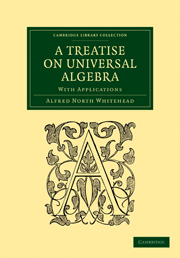Book contents
- Frontmatter
- PREFACE
- Contents
- BOOK I PRINCIPLES OF ALGEBRAIC SYMBOLISM
- BOOK II THE ALGEBRA OF SYMBOLIC LOGIC
- BOOK III POSITIONAL MANIFOLDS
- BOOK IV CALCULUS OF EXTENSION
- BOOK V EXTENSIVE MANIFOLDS OF THREE DIMENSIONS
- BOOK VI THEORY OF METRICS
- CHAPTER I THEORY OF DISTANCE
- CHAPTER II ELLIPTIC GEOMETRY
- CHAPTER III EXTENSIVE MANIFOLDS AND ELLIPTIC GEOMETRY
- CHAPTER IV HYPERBOLIC GEOMETRY
- CHAPTER V HYPERBOLIC GEOMETRY (continued)
- CHAPTER VI KINEMATICS IN THREE DIMENSIONS
- CHAPTER VII CURVES AND SURFACES
- CHAPTER VIII TRANSITION TO PARABOLIC GEOMETRY
- BOOK VII APPLICATION OF THE CALCULUS OF EXTENSION TO GEOMETRY
- Index
CHAPTER I - THEORY OF DISTANCE
Published online by Cambridge University Press: 29 August 2010
- Frontmatter
- PREFACE
- Contents
- BOOK I PRINCIPLES OF ALGEBRAIC SYMBOLISM
- BOOK II THE ALGEBRA OF SYMBOLIC LOGIC
- BOOK III POSITIONAL MANIFOLDS
- BOOK IV CALCULUS OF EXTENSION
- BOOK V EXTENSIVE MANIFOLDS OF THREE DIMENSIONS
- BOOK VI THEORY OF METRICS
- CHAPTER I THEORY OF DISTANCE
- CHAPTER II ELLIPTIC GEOMETRY
- CHAPTER III EXTENSIVE MANIFOLDS AND ELLIPTIC GEOMETRY
- CHAPTER IV HYPERBOLIC GEOMETRY
- CHAPTER V HYPERBOLIC GEOMETRY (continued)
- CHAPTER VI KINEMATICS IN THREE DIMENSIONS
- CHAPTER VII CURVES AND SURFACES
- CHAPTER VIII TRANSITION TO PARABOLIC GEOMETRY
- BOOK VII APPLICATION OF THE CALCULUS OF EXTENSION TO GEOMETRY
- Index
Summary
Axioms Of Distance. (1) In a positional manifold, to which no additional properties have been assigned by definition, no relation between any two points can be stated without reference to other points on the manifold. Thus consider a straight line which is a one-dimensional positional manifold. If e1 and e2 represent the reference elements at unit intensity, any point p can be written ξ1e1 + ξ2e2. But ξ1 is not the expression of a quantitive relation between p and e1. For ξ1 depends on ξ2, and ξ1/ξ2 a represents a relation of p to the terms e1 and e2. But even this does not properly represent a relation of the element represented by p to those represented by e1 and e2. For no determinate principles have been assigned by which the terms e1 and e2 should be considered to represent their corresponding elements at unit intensities. Thus the arbitrary assumption as to the intensities is included, when ξ1/ξ2 is considered as representing a quantitive relation of p to e1 and e2.
The only relations between points, which are independent of the intensities, are the anharmonic ratio between four points [cf. § 69 (1)], and functions of this anharmonic ratio.
(2) A spatial manifold will be defined to be a positional manifold, in which a quantitive relation between any two points is defined to exist. This quantitive relation will be called the distance, and the following axioms will be assumed to hold of it.
- Type
- Chapter
- Information
- A Treatise on Universal AlgebraWith Applications, pp. 349 - 370Publisher: Cambridge University PressPrint publication year: 2009First published in: 1898

